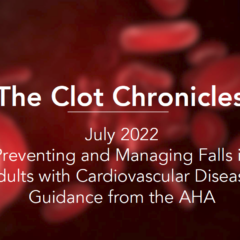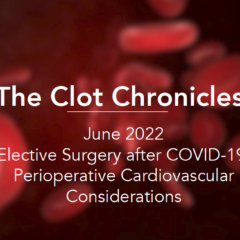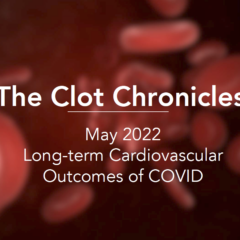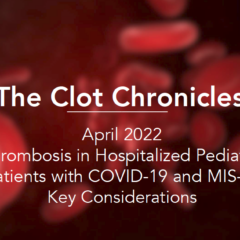Published on
Clot Chronicles: Trial Takeaways from ACC 2022
Hello, my name is Jen Ballard-Hernandez, and I’m a cardiology nurse practitioner at the Tibor Rubin VA in Long Beach, California. I’m excited to be able to share this Clot Chronicle for the North American Thrombosis Forum discussing some of the key late-breaking science presented at the recent American College of Cardiology meeting April 2-4, 2022, in Washington, DC.
Thousands of cardiovascular professionals from around the world came together for the first time in over 2 years to discuss practice-changing science and innovations. The excitement in the air was palpable and reaffirmed the importance of in-person learning and connections with colleagues.
The first trial I’ll be reviewing is the POISE-3 trial. Perioperative bleeding is a common complication in patients undergoing noncardiac surgery. Research into ways to improve vascular outcomes in patients undergoing noncardiac surgery has shown that both thrombotic issues and bleeding are important. Tranexamic acid, or TXA, is an antifibrinolytic drug that may safely decrease such bleeding. The question the investigators posed was as follows: in patients undergoing noncardiac surgery—who are at risk for bleeding and vascular events—does TXA reduce the occurrence of life-threatening major and critical organ bleeding?
They also looked at whether TXA was noninferior for the occurrence of major vascular complications within 30 days compared to placebo. The study was conducted at 114 centers in 22 countries and enrolling over 9,535 patients who were undergoing noncardiac surgery and deemed to be at risk for bleeding and vascular events. The initial target for enrollment was 10,000 patients, but due to slow recruitment related to the COVID-19 pandemic, the trial leadership decided to halt the study after 9,500 patients were included. About 80% of the trial participants were undergoing major surgery. And ultimately, POISE-3 was a partial 2×2 factorial designed randomized controlled trial.
So, let’s talk about the outcomes. In the current analysis, administration of TXA, given as a 1-gm IV bolus at the start and end of surgery, reduced the risk of composite bleeding events, as well as a wide range of other bleeding outcomes, including bleeding independently associated with mortality after noncardiac surgery, major bleeding, and transfusion of packed red blood cells. There were no significant differences between TXA and the placebo groups for life-threatening bleeding or critical organ bleeding.
The noninferiority of TXA versus placebo was not well established for this outcome, but there were no significant differences seen between trial arms for a variety of vascular outcomes, including MINS, which is myocardial injury after noncardiac surgery. Rates of all-cause mortality, vascular mortality, hemorrhagic shock, amputation, symptomatic pulmonary embolism, symptomatic DVT, and any proximal VTE were comparable between the two groups.
In conclusion, among patients undergoing noncardiac surgery, TXA reduced the risk of composite, life-threatening major and critical organ bleeding. TXA had no significant effect on major vascular complications, and noninferiority was not established. The future implications of this trial suggest that the use of TXA in noncardiac surgery reduces bleeding and could help alleviate worldwide blood shortages of blood products.
Next, I’d like to talk about the REVERSE-IT trial – bentracimab and its impacts on antiplatelet effects of ticagrelor in older people. Ticagrelor is an oral PY12 inhibitor that is effective in patients with acute coronary syndromes (ACS), prior myocardial infarction (MI), and high-risk coronary artery disease (CAD). As with other antiplatelet agents, spontaneous major bleeding and bleeding associated with urgent or emergent invasive procedures are concerns. The antiplatelet effects of ticagrelor cannot be reversed with platelet transfusion; therefore, a rapid-acting reversal agent would be very helpful and useful.
Bentracimab is a recombinant monoclonal antibody fragment that binds to free ticagrelor with a high affinity and specificity. This allows ADP to activate platelets while bentracimab and the ticagrelor complex is eliminated from the bloodstream. With that background, the investigators reported an interim analysis of the Phase 3 REVERSE-IT trial, which is a multicenter, open-label, prospective, single-arm study of the reversal agent effects of ticagrelor with bentracimab in at least 200 patients who present with uncontrolled major life-threatening bleeding or who have had surgery or invasive procedures. Patients with use of ticagrelor within the prior 3 days, who require urgent ticagrelor reversal, are ultimately eligible for enrollment — and enrollment is ongoing in North America and Europe.
The conclusion of the interim analysis is that compared to placebo, bentracimab significantly restored platelet function as measured by multiple assays by binding and eliminating free ticagrelor and ticagrelor active metabolite. No thrombotic events or serious adverse events (SAEs) were reported in volunteers randomized to bentracimab, confirming the safety profile.
Based on this data, bentracimab appears to be a promising option for ticagrelor reversal. Assessment of bentracimab’s clinical effect with bleeding awaits completion of the REVERSE-IT study, but the ultimate implications of the trial based on these interim data are that bentracimab appears to be a very promising option for ticagrelor reversal and may be important, in the future, to have in our armamentarium for patient care.
The next trial I’d like to discuss is the CHOCOLATE TOUCH trial, which was a randomized trial to confirm the safety and effectiveness of the Chocolate Touch paclitaxel-coated balloon catheter in above-the-knee lesions. This was presented on April 4th, 2022. Drug-coated balloons (DCBs) have demonstrated efficacy compared to balloon angioplasty; however, first-generation DCBs have a number of limitations, and it’s been reported that these limitations include acute dissection requiring bailout stenting, associated recoil, and minimal acute luminal gain.
The Chocolate Touch has a design that may address some of the limitations of the first-generation DCBs. The aim of the study for the investigators was to compare the efficacy and safety of the Chocolate Touch paclitaxel DCB, the commercially approved Lutonix® drug-coated balloon in an international randomized controlled trial. Chocolate Touch randomized 313 patients with intermittent claudication or ischemic rest pain (Rutherford category 2-4) and angiographic significant superficial femoral and popliteal PAD at 34 centers in the United States, Europe, and New Zealand.
As for the outcomes, the primary safety endpoint of freedom at 12 months from major adverse events—which was defined in this trial as a composite of target limb-related death, amputation, or reintervention—was not different between the Chocolate Touch and Lutonix group. There were no significant differences between groups in terms of dissection rates or flow-limiting dissections. The CHOCOLATE TOUCH study met the prespecified trial success criteria demonstrating that the Chocolate Touch was noninferior to the Lutonix DCB for both the primary efficacy and safety endpoints at 12 months.
In conclusion, in PAD patients, treatment with a second-generation paclitaxel DCB led to better target vessel patency and less repeat revascularization in a head-to-head comparison with a first-generation DCB. This has great implications. These results support the safety and efficacy of the Chocolate Touch DCB for the treatment of symptomatic patients with superficial femoral artery disease.
And the last study that I’ll be reviewing today in our Clot Chronicles is the Trends in Clinical Characteristics Management Strategies and Outcomes in STEMI Patients with COVID-19. This allowed us to look at reduction of mortality in STEMI patients in a COVID-19 vaccine era. This was presented on April 4th, 2022. We know that the risk of MI doubles within 1 to 2 weeks of receiving a COVID diagnosis. The investigators evaluated data from the North American COVID-19 Myocardial Infarction registry between 2020 and 2021. For this paper, the researchers analyzed data on 586 patients with STEMI who tested positive for COVID-19 during or within 4 weeks before their index STEMI hospitalization.
And the investigators concluded that in-hospital deaths decreased by a relative 25%, which was thought to be, in large, due to the fact that there’s a higher availability of COVID vaccinations. In this review, vaccinated patients were less likely to develop respiratory complications, and none of them expired in the hospital. But mortality remained high for unvaccinated patients, around 22% in the data that was reviewed. So, the implications are that STEMI outcomes have largely normalized for vaccinated patients but the unvaccinated face risks compounded by COVID-19 symptoms.
I hope you’ve enjoyed the brief recap of late-breaking science from ACC 2022. Thank you.



